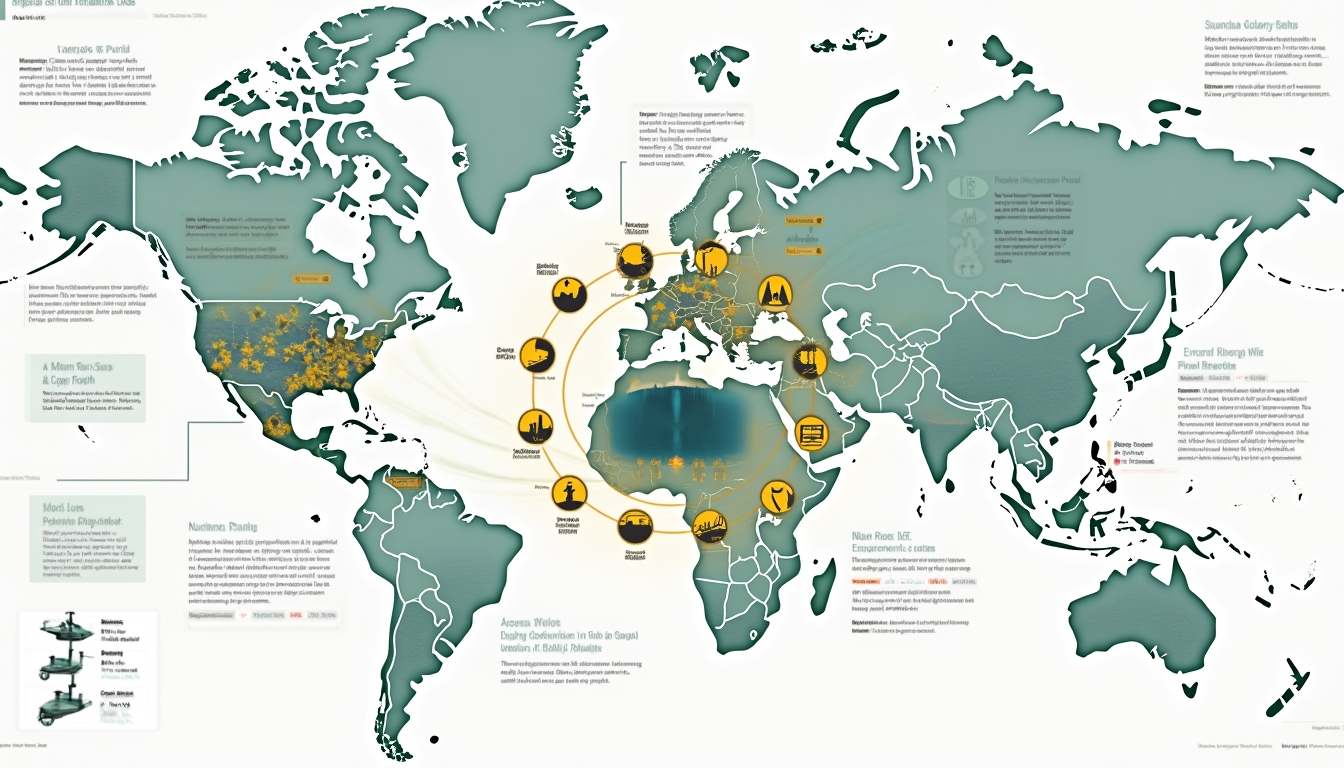Critical minerals are the driving force behind transformational economic and technological advancements. The deal between US and Ukraine on minerals is garnering significant attention as it promises to reshape supply chains and reduce global dependencies. The deal between US and Ukraine on minerals is being closely monitored by policymakers and industry experts. In this context, the deal between US and Ukraine on minerals holds substantial promise.
What Are Critical Minerals and Why Do They Matter?
Critical minerals include rare earth elements and strategic resources that are essential for advanced technologies, defence systems, and renewable energy infrastructure. These resources underpin a variety of technological innovations. For instance, neodymium is used in permanent magnets powering wind turbines. Lithium supports energy storage systems that are crucial for electric vehicles.
Their technological importance extends well beyond industrial applications.
- They support advanced electronics manufacturing.
- They are central to renewable energy developments.
- They enable aerospace and defence systems.
- They play a pivotal role in semiconductor production.
In addition, critical minerals like graphite are crucial for electric vehicle batteries, as discussed in unlocking ukrainian graphite reserves. The inclusion of these materials fosters innovation and sustainability in multiple industries.
Ukraine's Mineral Landscape: Potential and Challenges
Ukraine boasts an impressive mineral landscape that remains largely untapped. Out of the 50 critical minerals identified by the United States, 22 are found in Ukraine. This abundance positions the country as a promising strategic partner. The vast resource potential could transform Ukraine’s economic outlook if developed effectively.
Key minerals with strategic potential include:
- Titanium – essential for aerospace manufacturing.
- Zirconium – critical for nuclear technologies.
- Graphite – vital for electric vehicle battery production.
- Lithium – fundamental to renewable energy storage solutions.
Despite these prospects, Ukraine faces obstacles such as outdated Soviet-era surveys and incomplete resource mapping. These challenges hinder accurate reserve identification and extraction estimations. Furthermore, the uncertainties make it difficult to fully understand the potential of the deal between US and Ukraine on minerals in the near term.
What Is the Geopolitical Context Behind the Deal?
The geopolitical dynamics surrounding the mineral deal are complex. The strategic initiative aims to counteract China’s global dominance of mineral supplies. With an initial proposal valuing investments at around $500 billion, the plan envisages a joint reconstruction framework that collaborates beyond conventional economic partnerships.
The United States aims to:
- Curtail dependency on Chinese mineral supplies.
- Foster economic reconstruction in Ukraine.
- Develop alternative supply chains for critical minerals.
- Enhance technological autonomy.
This effort is seen as part of a broader trend, much like the critical minerals race navigating resource nationalism. Simultaneously, china's export challenges further reiterate the strategic importance of diversifying global supply chains.
The strategic and geopolitical considerations interlink domestic policy with international investment trends. As global powers realign, the deal between US and Ukraine on minerals becomes an essential element of this transformative agenda.
Mining Challenges in Ukraine
Mining operations within Ukraine are far from straightforward. Several operational challenges are causing disruptions:
- Ongoing military conflicts affecting infrastructure stability.
- Frequent power grid instabilities that limit continuous operations.
- High extraction and processing costs related to obsolete technology.
- Significant investments needed to rehabilitate ageing infrastructure.
Mining operations currently manage to function for approximately three hours daily, drastically reducing potential output. These limitations, coupled with logistical obstacles, undermine investor confidence and complicate the expansion of this strategic collaboration.
The obstacles highlight the long road ahead for the full realisation of the deal between US and Ukraine on minerals. However, overcoming these challenges could translate into a major leap for both geopolitical strategy and economic development.
Potential Economic Impact
The economic benefits arising from this initiative could be transformative. Key economic projections suggest:
- A potential to capture 7% of the global titanium production market.
- An estimated 3% share in global lithium reserves.
- Opportunities to restore significant aluminium production capacities.
- Extensive job creation and regional development.
These opportunities could lead to profound shifts in global market dynamics. Strategic investments in Ukraine’s mineral sector might unlock higher productivity and innovation. Some industry observers refer to the renewal of infrastructure as pivotal for unleashing future growth.
Moreover, the increased demand for minerals in clean energy developments is expected to shape global trends. For example, the critical mineral demand set to quadruple by 2040 serves as a strong indicator of long-term market strength.
What Obstacles Stand in the Way of Resource Development?
There are several critical obstacles that need to be addressed to ensure smooth development of Ukraine’s mineral resources.
- Russian-occupied territories continue to block access to rich deposits in some areas.
- The incomplete and outdated geological data hampers accurate resource mapping.
- Massive initial capital and technical investments are required to modernise mining infrastructure.
- Logistical challenges, such as an unreliable power grid, add significant hurdles for seamless operations.
The persistence of these issues underlines the urgency of addressing both security and infrastructure challenges. Recent external coverage, such as an analysis by bbc news, emphasises the complex intersection of geopolitics and resource development.
External experts further note that the pathway towards effective resource management may require international collaboration and robust policy reforms.
Future Outlook: What Lies Ahead?
Despite current obstacles, the future of Ukraine’s mineral sector holds promise. Future strategies aim to attract international investments, harness technological innovations, and foster integrated partnerships. The deal between US and Ukraine on minerals could pave the way for new economic corridors that benefit both nations.
Key forward-looking strategies include:
- Establishing dedicated funding channels from global investors.
- Modernising mining infrastructures to meet international standards.
- Enhancing geological surveys to capture more accurate data.
- Strengthening diplomatic ties to ensure political stability.
These measures are expected to stimulate local development, create jobs, and contribute positively to Ukraine’s economic recovery. Notably, the us-ukraine minerals deal 2025 unlocking strategic opportunities highlights how future collaborations may be approached.
Strategic Implications and Broader Conclusions
The deal between US and Ukraine on minerals is far more than an economic transaction; it represents a step towards strategic geopolitical realignment. This deal is instrumental in reducing dependency on dominant supply chains primarily controlled by competitors. Both nations seek to foster a more secure and resilient supply of critical minerals.
Additional benefits include:
- Geopolitical stability through diversified resource sources.
- Technological breakthroughs by integrating new mining practices and renewable energy approaches.
- Rejuvenation of strategic sectors such as defence and aerospace.
- Enhanced opportunities for regional economic integration.
Diplomatic channels continue to navigate complex international terrains, underscoring the significance of this evolving partnership. The deal between US and Ukraine on minerals symbolizes the drive towards future-oriented policies that support both national and global interests.
A recent article on bloomberg news illustrates the broader strategic implications as global leaders push for rapid realignment amid ongoing geopolitical uncertainties. This transformation is being propelled by both market forces and state-level strategies.
In conclusion, the future of the mineral sector in Ukraine hinges on extensive collaborations. Advances in technology and strategic foreign investments will be paramount. By addressing infrastructure deficits and establishing firm diplomatic bonds, the deal between US and Ukraine on minerals can foster a sustainable energy transition and reinforce the broader global economic order.
Policymakers and industry leaders alike must recognise that overcoming the present challenges will lead to long-term gains. The intricate balance between economic strategy and geopolitical stability will ultimately determine the success of this ambitious initiative.
Ready to Unlock Strategic Mineral Investment Insights?
Discovery Alert's proprietary Discovery IQ model delivers real-time alerts on critical mineral discoveries, transforming complex geological data into actionable investment opportunities. Begin your 30-day free trial today and position yourself ahead of the market's strategic mineral trends.







